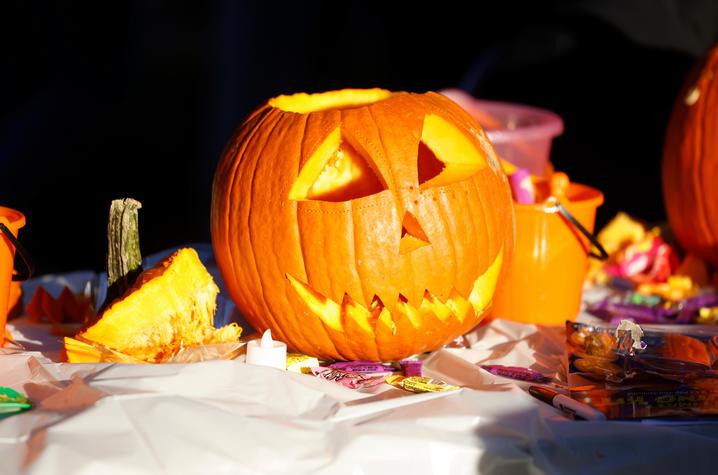By Tatum Armstrong and Lindsey Piercy

If you’re a big fan of spooky season, you’ve probably planned plenty of Halloween activities — like visiting the pumpkin patch and putting together a costume.
But even if you’re a Halloween enthusiast, there’s still a lot you may not know about the holiday.
Jeanmarie Rouhier-Willoughby, a professor in the Department of Modern and Classical Languages, Literatures and Cultures in the College of Arts and Sciences at the University of Kentucky, knows the spellbinding history of Oct. 31.
As a folklorist, Rouhier-Willoughby studies traditional culture, such as songs and stories, rituals and holidays, and objects.
Folklorists also focus on unofficial cultural forms to better understand how people develop their identity as a member of a group — be it a family, a region or state, a profession, an ethnicity or a hobby.
“Halloween, because it has lost the connection to the Christian calendar, allows for transgression more than other celebrations may,” Rouhier-Willoughby explained. “But at its heart, Halloween is no different than any other annual celebration. Holidays always give people a break from structure. But they also teach us about tradition.”
Now, you can deepen your knowledge of Halloween — including the origins of some our favorites traditions (from orange and black decorations to carving jack-o’-lanterns) — with this list of fun facts.
- Halloween is celebrated on Oct. 31, because of the Celtic calendar.
- The most important Celtic holiday was Samhain, which was the Celtic New Year (Nov. 1) celebration. As a result, Oct. 31 was Celtic New Year’s Eve.
- The New Year’s Eve celebration marked the end of the year and the beginning of a new agricultural cycle. It was the date when animals were slaughtered in preparation for the winter and harvests were completed.
- Halloween was brought to the U.S. in the 19th century by Irish immigrants. By the 1930s, non-Irish Americans began to celebrate the holiday as well.
- The name Halloween comes from All Hallows (meaning holy) Eve(ning), which refers to All Saints Day that follows on Nov. 1 in Catholicism.
- Jack-o'-lanterns are believed to have originated in Ireland in the 19th century — but they actually carved turnips instead of pumpkins at the time.
- The well-known orange and black colors come from pumpkins and the evil forces that Americans associate with the holiday, for example, witches and black cats.
- The idea of witches, and the attitude that Halloween is associated with evil forces (like the undead), derives from the American interpretation of the holiday, which came about during the medieval period in Europe and was brought to the U.S. by Puritans.
- Scarecrows symbolize the ancient agricultural roots of the holiday. They were designed to look like people and scare away crows to protect crops.
- In the 1900s, before the telephone was invented, Halloween cards were as popular as Christmas cards.
- Halloween was introduced back to adults in the 1960s-70s with costume parties.
- Trick-or-treating originated from mumming — groups of people go from house to house, ask for food and often offer a blessing to the household (people and animals) for the New Year in response to the treat. The trick refers to a punishment given to the household, including damage or cursing them in the New Year, if they refused to supply food.
- In Celtic traditions, both children and unmarried adults would go mumming. Today, of course, trick-or-treating is usually limited to children.
- Celts worried about bumping into the ghosts they believed came back to the earth on Halloween. To avoid being recognized, people would don masks when they left their homes after dark — in hopes the ghosts would mistake them for fellow spirits.
- Halloween was put on hold for several years during World War II due to sugar rationing.
- As a result of pop culture, Halloween in the U.S. has lost almost all connection to the Christian religious calendar.
- The popularity of Halloween continues to grow worldwide. It's now celebrated in Australia with costume parties, spooky decorations and children going trick-or-treating.
- Despite outward similarities — sweet treats, skeletons and people in costumes — Halloween and the Day of the Dead (Dia de los Muertos) are very different holidays.
- While Halloween promotes fear of the dead, Dia de los Muertos celebrates the dead. The Nov. 2 holiday is a day for people in Mexico, parts of Central and South America, and increasingly throughout the U.S., to honor those who have passed and invite those spirits back into their homes to be part of the family once more.
- People in the Pampanga province of the Philippines observe Pangangaluluwà from Oct. 29-31, leading up to All Souls Day on Nov. 2.
As the state’s flagship, land-grant institution, the University of Kentucky exists to advance the Commonwealth. We do that by preparing the next generation of leaders — placing students at the heart of everything we do — and transforming the lives of Kentuckians through education, research and creative work, service and health care. We pride ourselves on being a catalyst for breakthroughs and a force for healing, a place where ingenuity unfolds. It's all made possible by our people — visionaries, disruptors and pioneers — who make up 200 academic programs, a $476.5 million research and development enterprise and a world-class medical center, all on one campus.
In 2022, UK was ranked by Forbes as one of the “Best Employers for New Grads” and named a “Diversity Champion” by INSIGHT into Diversity, a testament to our commitment to advance Kentucky and create a community of belonging for everyone. While our mission looks different in many ways than it did in 1865, the vision of service to our Commonwealth and the world remains the same. We are the University for Kentucky.
